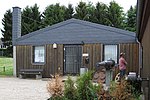Hürtgenwald

Hürtgenwald is a municipality in the district of Düren in the federal state of North Rhine-Westphalia, Germany. It is located in the Eifel hills, approx. 15 km south-west of Düren. Much of the area is covered by forest (Hürtgenwald in literal translation means Hürtgen Forest). Hürtgenwald is composed of the villages Bergstein, Brandenberg, Gey, Großhau, Horm, Hürtgen, Kleinhau, Raffelsbrand, Schafberg, Simonskall, Strass, Vossenack and Zerkall (in alphabetical order). Kleinhau with the town hall is not only the administrational center of the community, but has become the commercial center as well (shops and a few supermarkets). In World War II, Hürtgenwald was the theater of the Battle of Hürtgen Forest, a major battle. Two large war graves (one in Hürtgen, one in Vossenack) are places to commemorate those who fell. Nowadays, the pleasing landscape of forested hills, lakes and rivers attracts a lot of people from nearby densely populated areas, e.g. from the Cologne area and the Ruhr Area, for recreational reasons.
Excerpt from the Wikipedia article Hürtgenwald (License: CC BY-SA 3.0, Authors, Images).Hürtgenwald
Höhenstraße, Hürtgenwald
Geographical coordinates (GPS) Address Nearby Places Show on map
Geographical coordinates (GPS)
| Latitude | Longitude |
|---|---|
| N 50.71 ° | E 6.3744444444444 ° |
Address
Höhenstraße 74
52393 Hürtgenwald
North Rhine-Westphalia, Germany
Open on Google Maps








